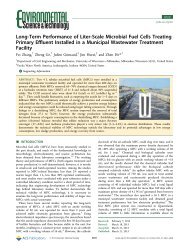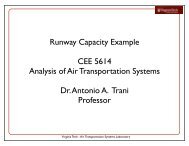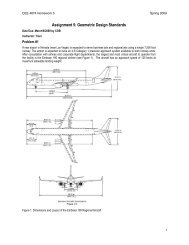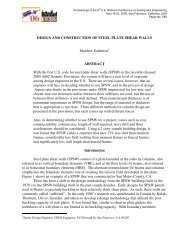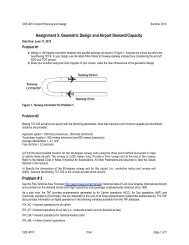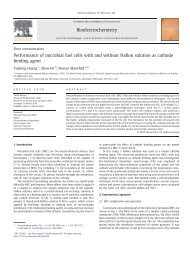Hydrogen production in microbial electrolysis cells: Choice of catholyte
Hydrogen production in microbial electrolysis cells: Choice of catholyte
Hydrogen production in microbial electrolysis cells: Choice of catholyte
You also want an ePaper? Increase the reach of your titles
YUMPU automatically turns print PDFs into web optimized ePapers that Google loves.
<strong>in</strong>ternational journal <strong>of</strong> hydrogen energy 38 (2013) 9619e9624 9623water (11.7 0.1 A/m 3 ) was twice that with the tap water(5.5 0.4 A/m 3 ), possibly because <strong>of</strong> the pH <strong>in</strong>fluence: the<strong>in</strong>itial pH <strong>of</strong> the DI water (4.7 0.0) was much lower than that<strong>of</strong> the tap water (7.3 0.3), <strong>in</strong>dicat<strong>in</strong>g that the proton supplymay have a more important role <strong>in</strong> current generation thanthe electrolyte conductivity. When the <strong>in</strong>itial pH was similar,for example, with the pH-2 water prepared by H 2 SO 4 or HCl, ahigher <strong>in</strong>fluent conductivity <strong>of</strong> the H 2 SO 4 <strong>catholyte</strong> led to ahigher peak current <strong>of</strong> (31.1 0.8 A/m 3 ) than that <strong>of</strong>25.7 0.3 A/m 3 with the HCl <strong>catholyte</strong>.<strong>Hydrogen</strong> <strong>production</strong> efficiencies and rates with different<strong>catholyte</strong>s are summarized <strong>in</strong> Table 1. The efficiency <strong>of</strong> thesubstrate-to-hydrogen (overall hydrogen recovery) varied between5% and 32%; <strong>in</strong>terest<strong>in</strong>gly, the DI water and the tapwater had comparable overall hydrogen recovery, as well ascoulombic recovery, with the other <strong>catholyte</strong>s. However, ittook a much longer time (3e5 days) for the MEC with the DI ortap water to complete a cycle, result<strong>in</strong>g <strong>in</strong> a much lowerhydrogen <strong>production</strong> rate. For the <strong>catholyte</strong>s <strong>of</strong> the PBS, theNaCl solution or the acidified water, the hydrogen <strong>production</strong>rates matched their current generation, and a higher currentled to a higher hydrogen <strong>production</strong> rate.The primary function <strong>of</strong> an MEC us<strong>in</strong>g wastewater as itsanode substrate is considered to be contam<strong>in</strong>ant removal;thus, COD reduction is a key parameter to evaluate the MECperformance. In general, the MEC achieved more than 94%<strong>of</strong> COD removal with all <strong>catholyte</strong>s except the tap water(Table 2), demonstrat<strong>in</strong>g a good performance <strong>in</strong> organicremoval. However, the COD removal rate was clearlyaffected by current generation and the period <strong>of</strong> a batchcycle, and the <strong>catholyte</strong>s such as the DI water and the tapwater with low hydrogen rates also yielded low CODremoval rates.We chose three <strong>catholyte</strong>s, 100-mM PBS, 134-mM NaCl, andacidified water pH 2 (H 2 SO 4 ), and conducted an extendedstudy without replac<strong>in</strong>g the <strong>catholyte</strong>. The peak currentdensities with the PBS and the acidified water clearlydecreased over time, but the NaCl ma<strong>in</strong>ta<strong>in</strong>ed a relativelystable current output. The hydrogen <strong>production</strong> rates, on theother hand, all decreased <strong>in</strong> the extended operat<strong>in</strong>g period(Fig. 2). Interest<strong>in</strong>gly, the hydrogen <strong>production</strong> rate with theacidified water showed a dramatic decrease <strong>in</strong> the second daywith a significant <strong>in</strong>crease <strong>in</strong> pH from 2.0 to 11.2, and thenslowly recovered <strong>in</strong> the follow<strong>in</strong>g six days with a further <strong>in</strong>crease<strong>of</strong> pH to 12.6 (Fig. 2(C)). The pH <strong>of</strong> the PBS <strong>in</strong>creasedfrom 7.3 to 12.3 <strong>in</strong> ten days and the NaCl <strong>catholyte</strong> had anelevated pH from 7.5 to 12.9 <strong>in</strong> six days. The f<strong>in</strong>al conductivity<strong>of</strong> the acidified water was 12.57 mS/cm, half <strong>of</strong> that <strong>of</strong> the PBSor NaCl <strong>catholyte</strong>s. All three <strong>catholyte</strong>s had a similar hydrogen<strong>production</strong> rate <strong>of</strong> 0.10 m 3 H 2 /m 3 /d at the end <strong>of</strong> their test<strong>in</strong>gperiod, <strong>in</strong>dicat<strong>in</strong>g that pH had more <strong>in</strong>fluence than <strong>catholyte</strong>conductivity on hydrogen <strong>production</strong>.The cost <strong>of</strong> a <strong>catholyte</strong> was estimated from the amount<strong>of</strong> the chemicals used and their bulk prices obta<strong>in</strong>ed fromSigmaeAldrich (St. Louis, USA). For an operation with frequentreplacement <strong>of</strong> the <strong>catholyte</strong> (as shown <strong>in</strong> Fig. 1), it would cost$3.39/m 3 H 2 with the 100-mM PBS, much higher than thehydrogen price ($0.42/m 3 estimated from $4.75/kg H 2 [9]). Theuse <strong>of</strong> the 134-mM NaCl or the acidified water (pH ¼ 2 adjustedby sulfuric acid) would cost $0.29/m 3 and $0.21/m 3 , respectively.In an extended use <strong>of</strong> the <strong>catholyte</strong> (as shown <strong>in</strong> Fig. 2), thecost <strong>of</strong> those three <strong>catholyte</strong>s (calculated from the first fourcycles) decreased because <strong>of</strong> the reuse: $1.50/m 3 with the100-mM PBS, $0.19/m 3 with the 134-mM NaCl, and $0.11/m 3with the acidified water (pH ¼ 2). The cost can be even less withadditional operat<strong>in</strong>g cycles us<strong>in</strong>g the same <strong>catholyte</strong> (Fig. 2(A)and (C)) and lower prices <strong>of</strong> raw chemicals <strong>in</strong> a larger quantity.Both the NaCl solution and the acidified water may be a betterchoice as an MEC <strong>catholyte</strong> than the PBS, because <strong>of</strong> thesignificantly lower cost. The use <strong>of</strong> PBS can also potentiallycause environmental problems by releas<strong>in</strong>g phosphorus <strong>in</strong>tonatural water bodies. Of course, challenges also exist with theuse <strong>of</strong> the NaCl or the acidified water and should be furtheraddressed; for example, the anode needs to have a sufficientalkal<strong>in</strong>ity when us<strong>in</strong>g a high-concentration NaCl <strong>catholyte</strong>[10], or the waste sulfate from the acidified water should beproperly disposed.4. Conclusions<strong>Hydrogen</strong> <strong>production</strong> <strong>in</strong> an MEC is affected by the pH buffer<strong>in</strong>gcapacity and the electrolyte conductivity <strong>of</strong> a <strong>catholyte</strong>. The100-mM PBS <strong>catholyte</strong> exhibited the best buffer<strong>in</strong>g capacityand also led to the highest hydrogen <strong>production</strong> rate, followedby the NaCl solution with a high electrolyte conductivity andthe acidified water that supplied additional protons to thecathode reaction. The tap/DI water, the low-concentration PBSand the acidified water at pH 4 had the lowest hydrogen <strong>production</strong>rates. The reuse <strong>of</strong> the cathode for an extended periodled to decreased hydrogen <strong>production</strong> rates, but could bejustified by cost sav<strong>in</strong>g. PBS may not be a good choice as an MEC<strong>catholyte</strong> because <strong>of</strong> its high cost and potential environmentaleffects. Both NaCl and acidified water could be considered asbetter choices. Future applications <strong>of</strong> those <strong>catholyte</strong>s <strong>in</strong> MECswill need to consider issues such as the <strong>catholyte</strong> cost (withfurther reductions), the <strong>catholyte</strong> reuse, and the disposal.AcknowledgmentsThis work was f<strong>in</strong>ancially supported by the Research Groupfor the Development <strong>of</strong> Microbial <strong>Hydrogen</strong> Production Processesfrom Biomass, Office <strong>of</strong> the Higher Education Commission,Thailand, and a research grant from the NationalScience Foundation (Award 1033505). We also thank Dr. MarjoriePiechowski (UW-Milwaukee) for pro<strong>of</strong>read<strong>in</strong>g themanuscript.references[1] Suwansaard M, Choorit W, Zeilstra-Ryalls JH, Prasertsan P.Isolation <strong>of</strong> anoxygenic photosynthetic bacteria fromSongkhla Lake for use <strong>in</strong> a two-staged biohydrogen<strong>production</strong> process from palm oil mill effluent. Int J<strong>Hydrogen</strong> Energy 2009;34:7523e9.[2] Manish S, Banerjee R. Comparison <strong>of</strong> biohydrogen<strong>production</strong> processes. Int J <strong>Hydrogen</strong> Energy 2008;33:279e86.



